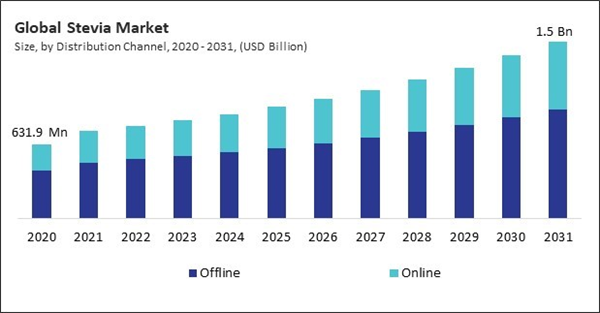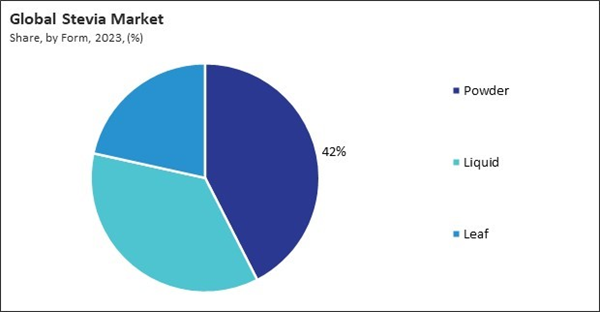The Global Stevia Market size is expected to reach $1.5 billion by 2031, rising at a market growth of 7.8% CAGR during the forecast period. In the year 2023, the market attained a volume of 12,488.77 tonnes, experiencing a growth of 11.5% (2020-2023).
To meet the demands of health-conscious consumers, food and beverage companies are integrating stevia into an extensive array of products, such as baked goods, confectionery, dairy, and beverages. Thus, the food and beverage segment acquired $289.77 million in 2023. Also, the Canada market would consume 271.20 tonnes of stevia in food and beverage segment. Soft drink manufacturers are reformulating their products to reduce sugar content and appeal to health-conscious consumers. Stevia offers an ideal solution for achieving sweetness without the added calories of sugar.
Stevia offers sweetness without the calories. Stevia is virtually devoid of calories, as opposed to sugar, which is abundant in calories and has been linked to adverse health effects, including weight gain. This makes it an attractive option for individuals looking to reduce their calorie intake, manage their weight, or maintain a healthier diet. Thus, these factors can help in the growth of the market.
Additionally, Stevia’s plant-based origin resonates with consumers looking for clean-label options closer to nature. An essential characteristic of stevia is its capacity to impart sweetness to products while preventing the addition of calories. Hence, these aspects will pose lucrative growth prospects for the market.
However, many consumers have grown accustomed to the taste of sugar and may find stevia’s flavor profile to be noticeably different. The perceived aftertaste or bitterness of stevia can be off-putting to individuals accustomed to sugar’s clean sweetness, leading them to prefer traditional sweeteners over Stevia-based alternatives. Therefore, these aspects can restrain the growth of the market.
To meet the demands of health-conscious consumers, food and beverage companies are integrating stevia into an extensive array of products, such as baked goods, confectionery, dairy, and beverages. Thus, the food and beverage segment acquired $289.77 million in 2023. Also, the Canada market would consume 271.20 tonnes of stevia in food and beverage segment. Soft drink manufacturers are reformulating their products to reduce sugar content and appeal to health-conscious consumers. Stevia offers an ideal solution for achieving sweetness without the added calories of sugar.
Stevia offers sweetness without the calories. Stevia is virtually devoid of calories, as opposed to sugar, which is abundant in calories and has been linked to adverse health effects, including weight gain. This makes it an attractive option for individuals looking to reduce their calorie intake, manage their weight, or maintain a healthier diet. Thus, these factors can help in the growth of the market.
Additionally, Stevia’s plant-based origin resonates with consumers looking for clean-label options closer to nature. An essential characteristic of stevia is its capacity to impart sweetness to products while preventing the addition of calories. Hence, these aspects will pose lucrative growth prospects for the market.
However, many consumers have grown accustomed to the taste of sugar and may find stevia’s flavor profile to be noticeably different. The perceived aftertaste or bitterness of stevia can be off-putting to individuals accustomed to sugar’s clean sweetness, leading them to prefer traditional sweeteners over Stevia-based alternatives. Therefore, these aspects can restrain the growth of the market.
Distribution Channel Outlook
Based on distribution channel, the market is divided into offline and online. In 2023, the offline segment witnessed a 64% revenue share in the market. In terms of volume, the offline segment would consume 15,120.56 tonnes of stevia by 2031. The growing popularity of stevia as a natural sweetener has led to increased retail presence and shelf space in stores worldwide.Form Outlook
Based on form, the market is segmented into powder, liquid, and leaf. In 2023, the liquid segment garnered a significant 36% revenue share in the market. In terms of volume, the liquid segment would consume 6,691.18 tonnes of stevia by 2031. Liquid stevia products offer convenience and ease of use, allowing consumers to precisely control the sweetness level in beverages, foods, and recipes. The liquid form allows easy mixing and blending, making it suitable for various applications, including beverages, smoothies, baked goods, and desserts. Therefore, owing to these factors, there will be enhanced demand in the segment.End User Outlook
On the basis of end user, the market is divided into food & beverages, pharmaceuticals, retail and others. The food and beverages segment recorded 34.3% revenue share in the market in 2023. In terms of volume, the food and beverages segment would consume 4,319.86 tonnes of stevia by 2031. As governments and public health organizations implement measures to address rising obesity rates and sugar-related health issues, there is growing demand for low-calorie and sugar-free options in the food and beverage industry.Type Outlook
By type, the market is segmented into reb A, reb M, and reb D. In 2023, the reb M segment acquired a considerable 31% revenue share in the market. In terms of volume, the reb M segment would consume 8,258.93 tonnes of stevia by 2031. Consumers are increasingly seeking natural ingredients with minimal processing. Reb M fits this trend perfectly as it is derived from the stevia leaf and is perceived as a more natural alternative to artificial sweeteners.Regional Outlook
By region, the market is segmented into North America, Europe, Asia Pacific, and LAMEA. The Asia Pacific segment procured a 38.4% revenue share in the market in 2023. In terms of volume, the Asia Pacific region would consume 10,580.98 tonnes of stevia by 2031. In recent years, as a result of rising obesity rates and other associated health issues (e.g., cardiovascular disease, diabetes), consumers in Asia Pacific have become more health conscious. As a result, there is a growing preference for healthier dietary choices, including reduced sugar consumption. Hence, the segment will grow rapidly in the coming years.Recent Strategies Deployed in the Market
- 2024-Feb: Tate & Lyle PLC came into partnership with Cryptobiotix, pioneers in preclinical gastrointestinal research. With this partnership, the company aimed to advance understanding regarding the role of low and no-calorie sweeteners in the diet.
- 2023-Mar: Tate & Lyle PLC signed a distribution partnership with IMCD, a large distributor of pharmaceutical ingredients and excipients. Through this partnership, the company aimed to expand its offering of sweetening, texture, stabilization, and fortification solutions to the food, beverage, nutrition, and supplement industries in Brazil.
- 2023-Jul: Tate & Lyle PLC revealed a new addition to its sweetener portfolio - TASTEVA SOL Stevia Sweetener. This innovation, internationally patent protected, represents a breakthrough in stevia technology. It enhances Tate & Lyle's capacity to assist customers in resolving stevia solubility challenges in food and beverages, thus fulfilling consumer demand for healthier and more flavorful products with reduced sugar and calories.
- 2022-Nov: Tate & Lyle PLC unveiled ERYTESSE Erythritol, a new addition to its sweetener portfolio. With this launch, the company expands its ability to assist customers in meeting consumer demand for healthier, sugar, and calorie-reduced products, and it extends Tate & Lyle’s position as the world leader in ingredient solutions for healthier food and beverages. ERYTESSE™ Erythritol possesses a clean taste and bulking properties that render it ideal for aiding manufacturers in meeting this demand, thus strengthening Tate & Lyle’s existing sweetening toolbox, as well as its overall portfolio.
- 2021-Sep: Ingredion Incorporated signed an agreement with S&W Seed Company, an agricultural seed technology company. Under this agreement, S&W will utilize its proprietary stevia plant portfolio and production techniques in order to provide Ingredion and its subsidiary PureCircle with high-quality stevia plants sourced from the United States.
List of Key Companies Profiled
- Ingredion Incorporated
- Tate & Lyle Plc
- The Coca Cola Company
- PepsiCo, Inc.
- Archer Daniels Midland Company
- Pyure Brands, LLC
- Cargill, Incorporated
- S&W Seed Company
- Morita Kagaku Kogyo Co., Ltd.
- Evolva Holdings SA
Market Report Segmentation
By Distribution Channel (Volume, Tonnes, USD Billion, 2020-2031)- Offline
- Online
- Powder
- Liquid
- Leaf
- Food & Beverages
- Retail
- Pharmaceuticals
- Others
- Reb A
- Reb M
- Reb D
- North America
- US
- Canada
- Mexico
- Rest of North America
- Europe
- Germany
- UK
- France
- Russia
- Spain
- Italy
- Rest of Europe
- Asia Pacific
- China
- Japan
- India
- South Korea
- Singapore
- Malaysia
- Rest of Asia Pacific
- LAMEA
- Brazil
- Argentina
- UAE
- Saudi Arabia
- South Africa
- Nigeria
- Rest of LAMEA
Table of Contents
Chapter 1. Market Scope & Methodology
Chapter 2. Market at a Glance
Chapter 3. Market Overview
Chapter 4. Global Stevia Market by Distribution Channel
Chapter 5. Global Stevia Market by Form
Chapter 6. Global Stevia Market by End User
Chapter 7. Global Stevia Market by Type
Chapter 8. Global Stevia Market by Region
Chapter 9. Company Profiles
Companies Mentioned
- Ingredion Incorporated
- Tate & Lyle Plc
- The Coca Cola Company
- PepsiCo, Inc.
- Archer Daniels Midland Company
- Pyure Brands, LLC
- Cargill, Incorporated
- S&W Seed Company
- Morita Kagaku Kogyo Co., Ltd.
- Evolva Holdings SA
Methodology

LOADING...










